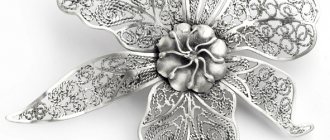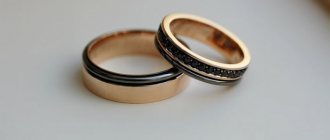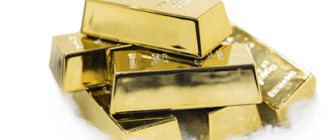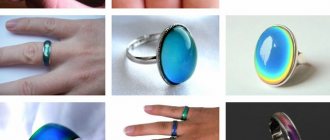Let this also be a master class, but not a visual one, as usual, but an informational and educational one.
In this article I will talk in detail about the technologies and techniques of jewelry enamels, about cloisonne enamel, about its history in Russia and in the world, about the main trends and applications of jewelry enamels at the present time.
I hope that you will find this article informative and interesting.
Enameling is the application of fusible glass to a metal surface. Modern enamels consist of silicon dioxide, titanium oxide, boric anhydride, aluminum oxide, oxides of alkali and alkaline earth metals, lead, zinc, and various fluorides.
Cold enamel
Cold enamel received its purpose due to the peculiarities of the application technique. Before applying to the jewelry, liquid enamel is prepared, which is mixed with catalysts. This produces a special paste, which is applied to the decoration. A thin tool is used for application. After application, the enamel dries for several days.
To increase the strength and durability of the enamel, ultraviolet light can be used to harden it. This allows you to speed up the drying procedure of the enamel. Cold enamel is quite easy to work with. In addition, the finished product rarely chips. Inexpensive jewelry is most often made using the cold enamel method.
History of origin
Enamel was used for products by the ancient Russians. They called it enamel. It was used not only to decorate jewelry, but also to decorate decorative and applied arts: bowls, goblets, caskets, and caskets.
The oldest items with original glaze were found in Cyprus during excavations. Also, traces of this creativity were found in Egypt, India, and Byzantium. Since the Byzantine Empire had close ties with Kievan Rus, this technology came to our region.
In the 10th-11th centuries in the Middle East, hot enamel was used to apply ornaments to utensils. The masters of the Byzantine Empire also applied it to dishes.
The heyday of enameling occurred in the XII-XVI centuries. Then the Chinese emperors ordered to combine metal with casting. This is how enamel began to be applied to copper. For this purpose, a special blue composition was created. Later, technology in blue tones became the property of Chinese applied art. Chinese enameling technique is popular all over the world. Patterns in heavenly colors cover not only jewelry, but also boxes, saucers, cups, vases, and glasses.
Later, the application of hot enamel began to be used not only for kitchen items, but also to frame icons, mirrors, and frames. In the 19th-20th centuries, the Art Nouveau style became popular, when jewelry and decorative items were decorated with artistic glaze. Chemistry has advanced greatly, and thanks to this, experts have developed a whole palette of enamel shades.
Hot enamel
To obtain a more beautiful decoration, you need to use a complex technique of hot enamel. However, using hot enamel requires special skill and special equipment. To do this, you need to dilute glass powder with water and draw patterns on the decoration like paint. After this, the product must be dried in a special oven so that air bubbles do not appear on the surface of the decoration. Therefore, products are fired at temperatures up to 900 degrees.
Jewelry can be quite complex. In this case, the master may need to apply several dozen layers of enamel, each of which must be fired in a kiln. The temperature at which the enamel is fired is selected based on the personal preferences of the master. That is why each product made using hot enamel has an individual design.
Jewelry enamel technique
Jewelry with enamel is the calling card of SOKOLOV. Thousands of women appreciated the collections Russe, My story, Etude and other jewelry of the brand. We will talk about how jewelry with cold and hot enamel is made and, just as important, how it is preserved in its original form.
Cold enamel
Cold enamels got their name due to the peculiarities of the technological process. Master enamellers are specialists of the highest class. This is one of the creative professions in jewelry production. It is also one of the most difficult - a craftsman can work on some jewelry all day long. Professionalism is especially important when making earrings. Both pieces included in the kit must look the same, which is especially difficult given the manual production.
Liquid two-component enamel is mixed in certain proportions with a catalyst, forming a creamy paste. Then, using a special tool, the enamel is applied to the metal surface. In some cases, the enamel is laid using a custom-designed tool with improved ergonomics, which allows you to paint over products in hard-to-reach places.
The cold enamel technique is different in that after application the enamel hardens at room temperature for 72 hours, and at a temperature of 60 degrees for 3 hours, and looks like a ceramic coating. In this case, the colorist can mix enamels to obtain different colors and shades according to the Pantone system. The enamel laid in this way is also called heat-curing.
A special type of enamel is light-curing. This is the name for a coating that hardens under the influence of special lighting.
The advantages of so-called cold enamels include the simplicity and manufacturability of their use. Coating application requires virtually no equipment, as well as specific preparation of the surface of the product. Enamels are perfectly applied to any alloys; they are flexible and quite unpretentious in use.
Hot enamel
The technology for applying hot enamel is more complex.
Initially, enamel is glassy plates. The artist crushes them and grinds them in a ceramic mortar to obtain the finest powder. The enamel powder is moistened with water to the desired consistency and mixed into a creamy paste.
Only after this can the coating be applied to the metal surface with a special tool. The hot enamel is then sent into the kiln and fired. Different types and colors of enamel have different firing temperatures, which range from 700 to 900 degrees. During firing, the powder fuses into a colored glassy layer and, depending on the type of enamel, becomes transparent or the so-called dull - that is, a colored opaque layer of enamel. Once cured, the product is sanded and returned to the oven to ensure a perfectly smooth surface.
Based on the characteristics of the composition of the product and the tasks facing the craftsman, the work can be fired from 5 to 100 times. The difficulty is that the master does not have the opportunity to intervene in the process, but can only, based on experience and intuition, regulate the firing time and temperature. This is what creates the uniqueness of each work with enamel - even the author cannot repeat it. Each work exists in only one copy, it is unique.
How to care for enamel jewelry?
Jewelry with enamel coating differs from other products not only in its original design, but also in its specific care. To maintain the original brightness of enamel paints, you must follow a few simple rules.
Rule 1. The decorative coating is a thin layer of glass, so it is sensitive to mechanical stress. An impact can cause chips and cracks in the enamel, so it is not recommended to drop products with enamel.
Rule 2. Jewelry with enamel must be protected from exposure to direct sunlight, as well as temperature changes. They are not recommended to be worn in a solarium, on the beach, in a bathhouse or sauna. Otherwise, the coating may fade or crack.
Rule 3. Do not allow enamel to come into contact with acids, alkalis and chlorine, that is, with any detergents, powders and cleaning gels. Also, the coating can be damaged by interaction with cosmetics (creams, lotions, shampoos, etc.) and sea water.
Rule 4. In order to maintain the brightness of the jewelry, but not damage the enamel coating, products with enamel must be washed in cool water, adding a small amount of ammonia. To clean the enamel, you can use a soft brush and tooth powder. Then the jewelry must be rinsed in clean water and wiped with a soft cloth. However, the best care for enamel jewelry can only be performed by a specialist in a jewelry workshop.
Rule 5. Products with enamel are recommended to be stored separately so that their surface does not come into contact with other metals.
Methods of applying enamel to jewelry
There are several basic techniques for applying enamel to jewelry. The most popular include:
- Cloisonne enamel. In this case, it is necessary to draw the outline of the future image on metal plastic. It is along this contour that thin metal strips will be soldered. The resulting cells are filled with powder, from which the enamel will be made. At this stage, the product is fired in a kiln, so the enamel melts, filling the metal partitions. After that, you just need to sand and polish the product.
- Stained glass enamel. The features of the technology are similar to the previous one. Stained glass enamel is also created by filling the openwork frame with enamel powder. However, in this case, a metal plate is not used as a base. In this case, colored translucent enamel is used, which, after firing, plays in the sun, reminiscent of stained glass. But creating stained glass enamel is difficult work. And a small mistake can lead to the need to start the work all over again.
- Picturesque enamel. This type of enamel involves the need to paint a real picture on a piece of jewelry. The metal base will act as a canvas, and the enamel will act as oil. After firing, the painted enamel acquires depth.
Enamels are also divided according to their appearance. According to this parameter, they can be divided into transparent, transparent colored, opal and opaque.
Where to buy jewelry creations with hot or cold enamel
Professional jewelers apply “paint” to the surface of precious metals. Accordingly, such products are sold in jewelry stores and workshops. You should not pay attention to offers “from unknown sources.” Jewelry, like classic versions with stones, must have jewelry tags. They will not indicate the composition of the enamel, but there will certainly be information about the type of alloy and the weight of the jewelry.
Follow the advice on choosing and caring for jewelry with enamel, then it will last you a long time. Remember that all such jewelry is made by hand, so their cost is not so low.
How to independently distinguish a product with cold and hot enamel
To understand what enamel is used to coat jewelry, you need to perform simple manipulations. First, you need to press some sharp object onto the enamel in an inconspicuous place. If it is done cold, it will leave a mark. In addition, cold enamel is warm to the touch, while hot enamel is, on the contrary, cold. This is due to the fact that cold enamel is a layer of special paint, and hot enamel is glass, which at high temperatures turns almost into stone. The product, made on the basis of cold enamel, is not polished, so it has small irregularities.
How to care for the finished product at home
Do you want your hot or cold enamel jewelry to retain its beauty for as long as possible? Follow simple rules for caring for such exclusive jewelry:
- The decorative layer is comparable to glass, so it does not withstand strong mechanical stress. Be careful not to hit or drop jewelry.
- Direct strong sunlight may heat the product and cause colors to lose vibrancy. Do not leave rings and earrings in the open sun. It is best to store them in a box.
- Acids, alkalis and bleach destroy the enamel surface. There is no need to wash the dishes and the floor when you are wearing rings with jewelry enamel on your hands.
- Rinse items under cold running water. You can drop a small amount of ammonia to remove dirt from the surface. And also use a toothbrush with soft bristles.
- It is advisable to store enamel jewelry separately from other jewelry. When in contact with certain metals, the color and brightness of the coating change.
And remember, the better you feel about jewelry, the longer it will delight you with its beauty and brilliance. Allow yourself neat luxury.
Jewelry with enamel - technique
Enameling is the application of fusible glass to a metal surface. Modern enamels consist of silicon dioxide, titanium oxide, boric anhydride, aluminum oxide, oxides of alkali and alkaline earth metals, lead, zinc, and various fluorides.
Enamels differ not only in composition, but also in the method of application to the surface of the metal base. In jewelry, the base is most often silver and gold. Jewelry is coated with colored enamels. They can be transparent or opaque. There are different methods and technologies for applying enamel.
Cloisonne enamel
. This is one of the most elegant performance techniques. Gold or silver partition ribbons are soldered onto the surface of the base according to the intended pattern, cells are formed, which are filled with enamel powder. Next, at a temperature of 600-800 degrees, the enamel powder is melted, turning into glass.
Instead of partition ribbons, filigree thread is sometimes used. The enamel itself is beautiful, and then there’s the gold or silver lace.
Champlevé enamel
. Using a special cutter, according to the drawing, metal particles are removed from the base, creating recesses that are filled with enamel composition. This is one of the most ancient technologies. Champlevé enamel can be made on a metal base that is initially engraved or embossed to match the design chosen. In costume jewelry, stamped blanks or blanks made by casting are used.
The technique of artistic enamel coating, or enamel.
This is a painting with colored enamel. There are no partitions or recesses here. The enamel is applied to the product in layers and fired until the plot planned by the designer is completed. It is in this technique that the masters of the enamel craft of Rostov the Great, as well as the Austrian brand Frey Wille, work.
Enamel is the Old Russian name for enamel, which comes from the Greek enamel, which means shiny, and the word enamel comes from the French (email). The art of decorating with enamel came to Russia from Byzantium back in the 10th century and reached perfection in the 16th - 17th centuries. In those days, all types of artistic enamels were called “enamel”, and only in the 19th century “enamel” was replaced by a new term - “enamel”.
Elegant Rostov enamel painting goes perfectly with fine filigree. And filigree (filigree) is one of the oldest types of artistic processing of metal or metal thread. The term filigree comes from the Latin words “phylum” - thread and “granum” - grain. The word filigree means to twist or twist. Thus, the twisted wire (filigree) is supplemented with small balls, making the enamel product more elegant and lacy.
Guilloche enamels are interesting.
Guilloche involves applying a fine engraved pattern, mainly geometric lines, to the surface of the base of the product. In modern jewelry, special installations with a rotating drum and a cutter (guilloche) are used.
Enameling this technique originated in the 18th century in France, and everything was much more difficult to do, however, what beautiful products of that time surprise and delight us to this day. In Russia, guilloché enamel began to be used to decorate precious jewelry in the late 19th - early 20th centuries and is associated with the name of Faberge. The tabletop items were especially luxurious.
In the guilloche enamel technique, only transparent enamels of various colors are used. It is thanks to this that the metal background with the pattern applied to it shines through under the enamel. Guilloche enamels in jewelry today are made mainly on gold or silver.
Stained glass enamel
- This is a type of cloisonne enamel, but without a metal base. This technique got its name because of its resemblance to stained glass. Translucent colored enamel is located in the nests of metal partitions and resembles colored stained glass.
Metal partitions are made from twisted gold, silver or copper wire. The openwork ornament makes the product fabulously beautiful. The production of stained glass enamel has its own difficulties - the product is fired more than once, but after each application of the next layer of enamel.
Seeded enamel
It is performed by spraying powders of multi-colored enamels onto a stencil base, where each layer is secured with glue.
The enamel is fixed in various ways, they are called hot and cold.
Relevant products in the Online store:
Redken
COLOR EXTEND BLONDAGE Professional ultra-pigmented purple mask for super cool blonde shades
from 2,970 rub.
Kérastase
BLOND ABSOLU Nourishing mask to neutralize yellow shades of blonde
from 3,366 rub.
Natura Siberica
MICELLAR SERIES Natural certified micellar beauty oil
299 rub.
sale
Organic Kitchen
Face mask Magic Transformation
from 533 rub.
All goods
Champlevé enameling
Champlevé enamel, or champlevé, is considered the oldest and easiest to produce. It consists of creating recesses in the metal. The glaze itself is easy to apply. With its help, color engravings are made, as well as grandiose images with alternating metal and enamel.
The most common starting metal is copper, as it is soft and easy to carve into. Their depth can be different, the color saturation depends on this. For the production of costume jewelry, they use already stamped blanks with recesses into which enamel of different shades is only poured.
Tricks for choosing quality products
Enameling is a painstaking process, so jewelry using this technique is not cheap. They are considered premium products. When buying jewelry with enamel, you should pay attention to the presence of cracks, chips, scratches, and bubbles. Gold is most suitable for it, because when heated it does not deform. Earrings with hot silver enamel look great. Copper items also harmonize well with glassy glaze. Storing and wearing jewelry with enamel requires the following rules:
- do not expose jewelry to impacts, protect it from friction with metal objects and surfaces;
- Monitor temperature changes to ensure that the products are not exposed to sunlight;
- put on jewelry after applying makeup;
- avoid contact with chemicals;
- wipe the enamel with a soft cloth;
- remove earrings and rings with glaze before going to the pool, shower, or bathhouse;
- choose jewelry from famous brands (Sokolov, Sunlight).
Cloisonne enamel
Jewelry with cloisonne enamel is one of the most elegant techniques. A design is laid out on a plate of precious metal using thin silver wires. Glaze is applied inside these partitions.
In ancient times, this technique was used to shade the entire beauty of gemstones in a piece. The jewelry of Ancient India that has survived to this day demonstrates all the diversity of colors of pure gems. Also, the product could be provided with chasing, and all this was called “minankari”.
In the Chinese tradition, on the contrary, it was not customary to combine glaze and jewelry stones. It was a very delicate work, akin to modern printing. Cloisonne enamel was mainly used on valuable household items. Vessels and vases were decorated with traditional images of real and mythical animals. In Europe and Russia, a similar technique is called stained glass enamel.
True cloisonné technique is an example of delicate and labor-intensive work. This is a one-of-a-kind item, unique in its kind.
There is no mass production here. With its help, exclusive jewelry is prepared for a specific customer.
Signs of septal enamel:
- fine work drawing;
- the contours are formed by a thin wire, which can be seen in its entirety, even in the photo;
- the price of the product is quite high.
Jewelry using this technique is rarely found in large production facilities, nor are they found in large jewelry stores that work with major brands. Similar products can be found in small jewelry workshops, on Internet resource sites dedicated to handmade topics, and at exhibitions.
In such places you can actually get original jewelry with history.
Technology of products with cloisonne enamel
If you look at the drops collected in the web after rain, you can understand the principle of cloisonne enamel. First, a contour is laid out with wire, which is then filled with a multi-colored mass. The product dries and is fired. One gets the impression that glass is framed in metal lace.
Enameling technology is quite labor-intensive:
- a sketch is applied to a metal base with white gouache;
- the workpiece is cut or minted according to the design;
- the base for the product is bleached in acid before being covered with a layer of enamel, then fired in an oven at a temperature of 800C;
for partitions, 999-grade wire is used: here you work with tweezers and pliers. Frame elements are formed, which are fastened with a special glue that burns out when fired;- The glaze is diluted with water and poured into the cells. First, the product needs to dry so that the water does not disturb the structure of the design;
- the decoration is placed in a preheated muffle furnace;
- The product cannot be exposed to sudden temperature changes, so it must cool naturally.
Firing can occur many times to achieve the desired color and shade. The cloisonne technique differs from stained glass in that it has a base. Stained glass enamel is transparent to light, like glass.
Types of cold enameling
Cold enamel is a kind of fiberglass, it is easy to apply. There are three types of cold enameling:
- Two-component cold mixture. It is simply poured onto the decoration. First, dilute the mixture to a cream consistency by adding a catalyst to it. Then, using a tool, they apply it to a metal surface. In order for the applied mixture to harden, it is kept for 48 hours at room temperature, then kept for 20 hours at a temperature of 70 ° C. The surface will look like ceramics. The shades of this glaze can be mixed.
- Heat-curing glaze. It is similar to hot pour, but is fired at a temperature of 160 °C. A distinctive feature is that it is not polished so as not to leave matte marks on it. This glaze is not very strong. If you press it hard with something, it will leave a dent.
- Light-curing fill. This process is similar to filling teeth with liquid paste. The applied glaze is irradiated using an ultraviolet lamp, after which the enamel hardens. This technique is most often used to repair chips in jewelry. The light-curing mixture is quite hard and is considered intermediate between cold and hot enamel.









